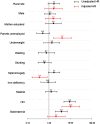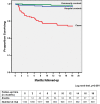Long term outcome of severe anaemia in Malawian children
- PMID: 18682797
- PMCID: PMC2488370
- DOI: 10.1371/journal.pone.0002903
Long term outcome of severe anaemia in Malawian children
Abstract
Background: Severe anaemia is a common, frequently fatal, condition in African children admitted to hospital, but its long term outcome is unknown. Early reports that survivors may be at risk of additional late morbidity and mortality may have significant implications for child survival in Africa. We assessed the short and long term outcome of severe anaemia in Malawian children and identified potential risk factors for death and further severe anaemia.
Methodology and findings: For 18 months, we followed up children (6-60 months old) presenting to hospital with severe anaemia (haemoglobin <or=5 g/dl) and their hospital and community controls with the aim to compare all cause mortality and severe anaemia recurrence rates between the groups, and to identify risk factors for these adverse outcomes. A total of 377 cases, 377 hospital controls and 380 community controls were recruited. Among cases, the in-hospital mortality was 6.4% and post-discharge all cause mortality was 12.6%, which was significantly greater than in hospital controls (2.9%) or community controls (1.4%) (Log rank test, p<0.001). The incidence of recurrence of severe anaemia among the cases was 0.102 per child-year (95% Confidence Interval 0.075-0.138), and was significantly higher than the 0.007 per child-year (95% CI 0.003-0.015) in the combined controls (p<0.0001). HIV was the most important risk factor both for post-discharge mortality (Hazard Ratio 10.5, 95% CI 4.0-27.2) and for recurrence of severe anaemia (HR 5.6, 95% CI 1.6-20.1).
Conclusions: Severe anaemia carries a high 'hidden' morbidity and mortality occurring in the months after initial diagnosis and treatment. Because severe anaemia is very common, this is likely to contribute importantly to overall under-five mortality. If not adequately addressed, severe anaemia may be an obstacle to achievement of the Millennium development goal No.4 on child survival. Strategies to diagnose and properly treat HIV infected children early most likely will reduce the high post-discharge mortality in severe anaemia.
Conflict of interest statement
Figures



References
-
- Bojang KA, Van Hensbroek MB, Palmer A, Banya WA, Jaffar S, et al. Predictors of mortality in Gambian children with severe malaria anaemia. Ann Trop Paediatr. 1997;17:355–359. - PubMed
-
- Lackritz EM, Campbell CC, Ruebush TK, 2nd, Hightower AW, Wakube W, et al. Effect of blood transfusion on survival among children in a Kenyan hospital. The Lancet. 1992;340:524–528. - PubMed
-
- Marsh K, Forster D, Waruiru C, Mwangi I, Winstanley M, et al. Indicators of life-threatening malaria in African children. New England Journal of Medicine. 1995;332:1399–1404. - PubMed
-
- Koram KA, Owusu-Agyei S, Utz G, Binka FN, Baird JK, et al. Severe anemia in young children after high and low malaria transmission seasons in the Kassena-Nankana district of northern Ghana. Am J Trop Med Hyg. 2000;62:670–674. - PubMed
-
- Dicko A, Klion AD, Thera MA, Sagara I, Yalcouye D, et al. The etiology of severe anemia in a village and a periurban area in Mali. Blood. 2004;104:1198–1200. - PubMed
Publication types
MeSH terms
Grants and funding
LinkOut - more resources
Full Text Sources
Medical

